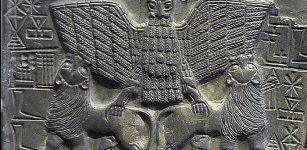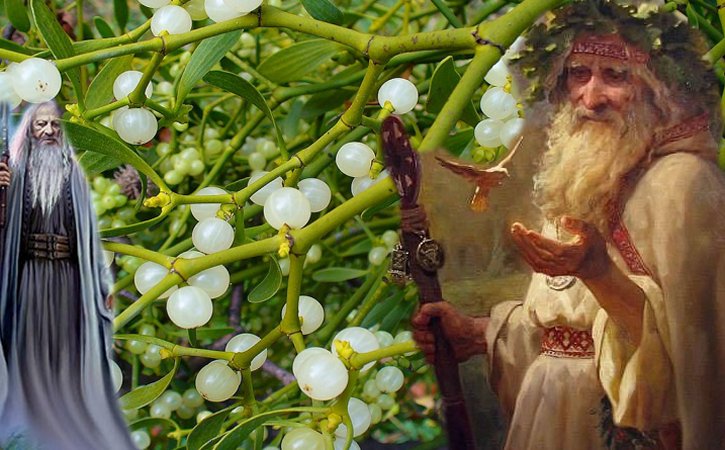Ancient Secrets Of Mistletoe – Sacred Celtic Plant With Magical Powers
Ellen Lloyd - AncientPages.com - Today, we associate mistletoe with Christmas. We decorate with mistletoe and don't think much about how this wonderful plant entered our homes.
To many of us, mistletoe is simply one of many Christmas traditions, but the use of the remarkable plant started a very long time ago.
Mistletoe Offered Protection Against Evil Spirits
Mistletoe is an evergreen plant with white berries that can grow in trees in North America and Europe.
The origins of mistletoe as decoration may lie in the ancient belief that it protected against thunder and lightning and warded off evil spirits.
During the Middle Ages, mistletoe branches were hung from ceilings to ward off evil spirits.
In Europe, they were placed over houses and stable doors to prevent the entrance of witches.
People believed mistletoe possessed mystical powers that could bring good luck to a family during December.
Why Mistletoe Was Sacred To Ancient People
In ancient times, mistletoe was considered a miracle plant and sacred to the Celts, the Norse, and the North American Native Americans. Mistletoe stunts the growth of its host trees and can even kill them if it gets too big.
It may sound strange that a parasite, a plant that sucks the life out of another organism, could inspire such awe, but the mistletoe is unique and much different from most of nature's other parasites.
This beautiful, flowing plant flourishes at a time when all other living creatures fight for life. It seems to grow out of nothing and yet appears to be everywhere. Its growth cannot be controlled, nor, it seems, can the plant be eradicated.
The mistletoe was sacred to Celts. Credit: Adobe Stock - Archivist
Pliny the Elder, the Roman philosopher and naturalist, wrote that the Celts used the plant as an antidote to poison and increase their cattle's fertility. In the Celtic language, mistletoe means "All Heal."
In Norse myths and legends, mistletoe is described as the only thing that could kill the god Balder, the son of the God Odinand brother of the God Thor.
The plant had healing properties, and ancient people considered it sacred. It has been used as an herbal remedy in Europe and by Native Americans for hundreds of years.
It is still an ingredient in some homeopathic medicines, and scholars test the plant's medical use in modern times. It has been used to treat epilepsy, apoplexy, palsy, tuberculosis, stroke, and cancer.
 According to Norse mythology, God Balder was killed by a mistletoe arrow, and his mother, Frigga wept white berries, which brought him back to life. Baldr's Death by Christoffer Wilhelm Eckersberg (1783–1853). Credit: Public Domain
According to Norse mythology, God Balder was killed by a mistletoe arrow, and his mother, Frigga wept white berries, which brought him back to life. Baldr's Death by Christoffer Wilhelm Eckersberg (1783–1853). Credit: Public Domain
In Norse mythology, the mistletoe was a symbol of love and friendship. This explains the origin of the custom of kissing under the mistletoe.
Mistletoe was also a Druidic symbol of joy and peace.
The hanging of mistletoe and the custom kissing beneath it is a popular tradition in Christmas celebrations.
When you bring the plant to your house, don't forget that mistletoe is one of the most magical, mysterious, and sacred plants of all time.
Updated on December 10, 2023
Written by Ellen Lloyd – AncientPages.com
Copyright © AncientPages.com All rights reserved. This material may not be published, broadcast, rewritten or redistributed in whole or part without the express written permission of AncientPages.com
Expand for referencesMore From Ancient Pages
-
 How Did The Early Rapa Nui People Put Huge Hats On Giant Statues Of Easter Island?
Ancient Technology | Jun 5, 2018
How Did The Early Rapa Nui People Put Huge Hats On Giant Statues Of Easter Island?
Ancient Technology | Jun 5, 2018 -
 New Study Questions Claims Homo Naledi Was Advanced
Evolution | Nov 13, 2023
New Study Questions Claims Homo Naledi Was Advanced
Evolution | Nov 13, 2023 -
 500-Year-Old Shiva Temple Constructed On Rock Without Foundation Pits Needs Repairs
News | Sep 7, 2015
500-Year-Old Shiva Temple Constructed On Rock Without Foundation Pits Needs Repairs
News | Sep 7, 2015 -
 Centeotl: Lord Of Maize Who Was Revered Before The Olmecs By All Mesoamerica’s Inhabitants
Featured Stories | Feb 20, 2024
Centeotl: Lord Of Maize Who Was Revered Before The Olmecs By All Mesoamerica’s Inhabitants
Featured Stories | Feb 20, 2024 -
 Interbreeding With Modern Humans Wiped Out Neanderthals’ Y Chromosomes 100,000 Years Ago
Archaeology | Sep 28, 2020
Interbreeding With Modern Humans Wiped Out Neanderthals’ Y Chromosomes 100,000 Years Ago
Archaeology | Sep 28, 2020 -
 Félag – Ancient Viking Company Organized Trade Finance
Ancient History Facts | May 4, 2018
Félag – Ancient Viking Company Organized Trade Finance
Ancient History Facts | May 4, 2018 -
 Fossils In The ‘Cradle Of Humankind’ May Be More Than A Million Years Older Than Previously Thought
Archaeology | Jun 28, 2022
Fossils In The ‘Cradle Of Humankind’ May Be More Than A Million Years Older Than Previously Thought
Archaeology | Jun 28, 2022 -
 Controversial Artifact: What Kind Of Message Does The Phaistos Disk Contain?
Artifacts | May 13, 2014
Controversial Artifact: What Kind Of Message Does The Phaistos Disk Contain?
Artifacts | May 13, 2014 -
 Urukagina: Ruler Of Sumerian City Of Lagash And His Reforms To Combat Corruption
Civilizations | May 18, 2017
Urukagina: Ruler Of Sumerian City Of Lagash And His Reforms To Combat Corruption
Civilizations | May 18, 2017 -
 Why Are There No Unicorn Fossils In A Museum?
Archaeology | Mar 17, 2023
Why Are There No Unicorn Fossils In A Museum?
Archaeology | Mar 17, 2023 -
 Well-Preserved Fragments Of Epetion’s Wall Discovered At The Hellenistic Site Of Stobreč, Near Split, Croatia
Archaeology | Oct 11, 2024
Well-Preserved Fragments Of Epetion’s Wall Discovered At The Hellenistic Site Of Stobreč, Near Split, Croatia
Archaeology | Oct 11, 2024 -
 ‘Lios na Grainsi’ – Ireland’s Largest Stone Circle
Civilizations | Feb 3, 2016
‘Lios na Grainsi’ – Ireland’s Largest Stone Circle
Civilizations | Feb 3, 2016 -
 DNA Study Shows Pre-Historic Wallacea Was A Melting Pot Of Human Genetic Ancestries
Archaeology | Jun 9, 2022
DNA Study Shows Pre-Historic Wallacea Was A Melting Pot Of Human Genetic Ancestries
Archaeology | Jun 9, 2022 -
 Ogdoad Of Hermopolis – Ancient Egyptian Concept Of Eternal And Primeval Forces
Egyptian Mythology | May 16, 2019
Ogdoad Of Hermopolis – Ancient Egyptian Concept Of Eternal And Primeval Forces
Egyptian Mythology | May 16, 2019 -
 Mysterious Gigantic Jars Of Unknown Origin Discovered Worldwide
Artifacts | Dec 27, 2018
Mysterious Gigantic Jars Of Unknown Origin Discovered Worldwide
Artifacts | Dec 27, 2018 -
 Mysterious Megaliths Of Russia May Offer Evidence Of An Ancient Advanced Lost Civilization
Ancient Technology | Jul 22, 2017
Mysterious Megaliths Of Russia May Offer Evidence Of An Ancient Advanced Lost Civilization
Ancient Technology | Jul 22, 2017 -
 A Researcher’s Life’s Work Uncovers First Ancient DNA From Swahili Civilization
Archaeology | Apr 2, 2023
A Researcher’s Life’s Work Uncovers First Ancient DNA From Swahili Civilization
Archaeology | Apr 2, 2023 -
 2,600-Year-Old Blocks Of White Cheese Discovered At Giza’s Saqqara Necropolis, Egypt
Archaeology | Sep 15, 2022
2,600-Year-Old Blocks Of White Cheese Discovered At Giza’s Saqqara Necropolis, Egypt
Archaeology | Sep 15, 2022 -
 Enigmatic Human Fossil Jawbone May Be Evidence Of An Early Homo Sapiens Presence In Europe
Evolution | May 2, 2023
Enigmatic Human Fossil Jawbone May Be Evidence Of An Early Homo Sapiens Presence In Europe
Evolution | May 2, 2023 -
 Cosmic Impact Destroyed Huge Ancient City In The Jordan Valley – Evidence Has Been Found!
Archaeology | Sep 22, 2021
Cosmic Impact Destroyed Huge Ancient City In The Jordan Valley – Evidence Has Been Found!
Archaeology | Sep 22, 2021


